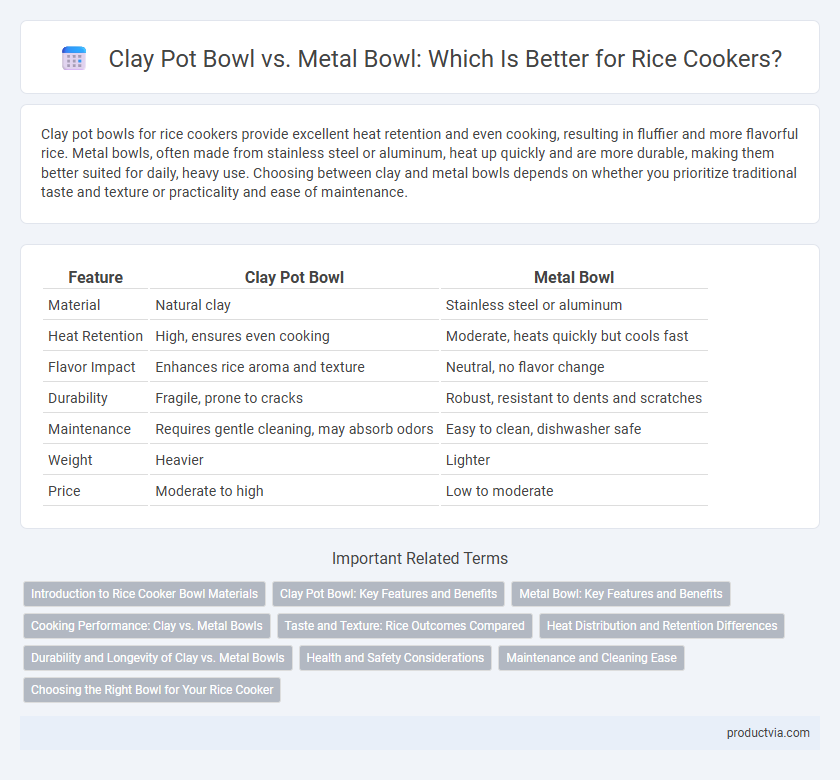Clay pot bowls for rice cookers provide excellent heat retention and even cooking, resulting in fluffier and more flavorful rice. Metal bowls, often made from stainless steel or aluminum, heat up quickly and are more durable, making them better suited for daily, heavy use. Choosing between clay and metal bowls depends on whether you prioritize traditional taste and texture or practicality and ease of maintenance.
Table of Comparison
| Feature | Clay Pot Bowl | Metal Bowl |
|---|---|---|
| Material | Natural clay | Stainless steel or aluminum |
| Heat Retention | High, ensures even cooking | Moderate, heats quickly but cools fast |
| Flavor Impact | Enhances rice aroma and texture | Neutral, no flavor change |
| Durability | Fragile, prone to cracks | Robust, resistant to dents and scratches |
| Maintenance | Requires gentle cleaning, may absorb odors | Easy to clean, dishwasher safe |
| Weight | Heavier | Lighter |
| Price | Moderate to high | Low to moderate |
Introduction to Rice Cooker Bowl Materials
Rice cooker bowls commonly come in clay and metal materials, each offering distinct thermal properties that affect cooking performance. Clay pot bowls provide even heat distribution and retain moisture well, enhancing the texture and flavor of rice through slow, consistent cooking. Metal bowls, often made of aluminum or stainless steel, heat up quickly and are more durable, ensuring efficient cooking cycles and ease of maintenance.
Clay Pot Bowl: Key Features and Benefits
Clay pot bowls in rice cookers offer superior heat retention and even heat distribution, resulting in consistently well-cooked rice with enhanced flavor and texture. The porous nature of clay absorbs excess moisture, preventing sogginess and promoting a fluffier grain. Additionally, clay pots are eco-friendly and free from harmful chemicals, making them a healthier choice for cooking rice.
Metal Bowl: Key Features and Benefits
Metal bowls for rice cookers offer superior durability and excellent heat conductivity, ensuring even cooking and consistent rice texture. Their lightweight nature makes handling and cleaning easier compared to clay pots, while resistance to chipping and cracking extends the lifespan of the rice cooker accessories. Stainless steel and aluminum metal bowls also provide compatibility with various cooking modes, including steaming and slow cooking, enhancing the versatility of your rice cooker.
Cooking Performance: Clay vs. Metal Bowls
Clay pot bowls in rice cookers retain heat evenly and impart subtle earthy flavors, enhancing rice texture and aroma, while metal bowls, typically aluminum or stainless steel, provide faster heat conduction and more rapid cooking times. Clay bowls excel in slow, uniform cooking that preserves moisture, resulting in fluffy, well-cooked rice, whereas metal bowls offer durability and ease of cleaning but may cause uneven heat distribution if not designed with quality coatings. Selecting between clay and metal depends on prioritizing traditional cooking quality versus efficiency and maintenance convenience.
Taste and Texture: Rice Outcomes Compared
Clay pot bowls in rice cookers retain heat evenly, producing rice with a moist, tender texture and enhanced natural flavor due to better moisture absorption. Metal bowls, often made of aluminum or stainless steel, heat quickly but may result in drier rice with less depth in taste because of uneven heat distribution. Choosing a clay pot bowl can significantly improve rice quality by promoting uniform cooking and richer aroma retention.
Heat Distribution and Retention Differences
Clay pot bowls in rice cookers provide superior heat retention and even heat distribution, resulting in consistently cooked rice with minimal hotspots. Metal bowls, usually made from aluminum or stainless steel, heat up quickly but can cause uneven cooking due to faster heat loss and concentrated hot spots. The porous nature of clay absorbs moisture, enhancing rice texture, while metal bowls offer durability and faster cooking times but less effective heat retention.
Durability and Longevity of Clay vs. Metal Bowls
Clay pot bowls in rice cookers offer excellent heat retention and slow, even cooking but are more prone to cracking or chipping with sudden temperature changes. Metal bowls, usually made from stainless steel or aluminum, provide superior durability, resist warping, and endure frequent use and high heat without damage. For long-term reliability, metal bowls generally outlast clay pots, making them ideal for heavy daily use.
Health and Safety Considerations
Clay pot bowls for rice cookers offer natural heat retention and are free from harmful chemicals, reducing the risk of metal leaching and ensuring safer cooking. Metal bowls, typically made from stainless steel or aluminum, provide durability but may pose concerns about aluminum exposure or scratches that harbor bacteria if not properly maintained. Choosing a clay pot enhances health safety by preventing chemical contamination, while metal bowls require careful upkeep to avoid health risks.
Maintenance and Cleaning Ease
Clay pot bowls require gentle cleaning with non-abrasive sponges to prevent cracking and are prone to absorbing stains and odors, making maintenance more delicate. Metal bowls, often made of stainless steel or aluminum with non-stick coatings, offer superior durability and straightforward cleaning, typically dishwasher-safe and resistant to residue buildup. Choosing metal bowls enhances cleanliness and reduces maintenance time, especially in busy kitchens.
Choosing the Right Bowl for Your Rice Cooker
Choosing the right bowl for your rice cooker significantly affects cooking quality and durability. Clay pot bowls offer superior heat retention and even heat distribution, enhancing the flavor and texture of rice, while being ideal for slow cooking and retaining moisture. Metal bowls, typically stainless steel or aluminum, provide faster heating and greater resistance to scratches and corrosion, making them more durable and easier to clean for everyday use.
Clay pot bowl vs metal bowl for rice cookers Infographic

 productvia.com
productvia.com